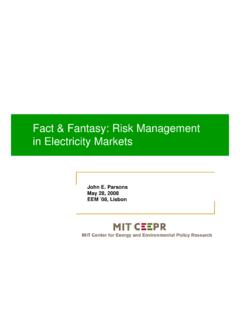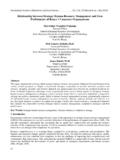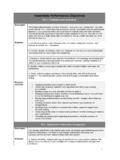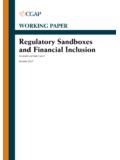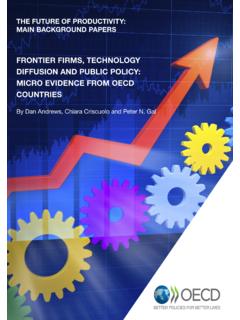Transcription of MEASURING THE ''WORLD'' REAL INTEREST RATE …
1 NBER working PAPER SERIESMEASURING THE '' world '' real INTEREST RATEM ervyn KingDavid LowWorking Paper 19887 BUREAU OF ECONOMIC RESEARCH1050 Massachusetts AvenueCambridge, MA 02138 February 2014 The authors thank Iain de Weymarn, Andrew Hauser, and David Backus for many insightful commentsthat greatly enhanced this paper. We also gratefully acknowledge research support from the SternSchool of Business at New York University. The views expressed herein are those of the authors anddo not necessarily reflect the views of the National Bureau of Economic working papers are circulated for discussion and comment purposes.
2 They have not been peer-reviewed or been subject to the review by the NBER Board of Directors that accompanies officialNBER publications. 2014 by Mervyn King and David Low. All rights reserved. Short sections of text, not to exceedtwo paragraphs, may be quoted without explicit permission provided that full credit, including notice,is given to the the '' world '' real INTEREST RateMervyn King and David LowNBER working Paper No. 19887 February 2014 JEL No. E4,E43,G12 ABSTRACTOver the past couple of decades, and especially since the financial crisis in 2008-09, real INTEREST rateshave collapsed.
3 For much of the past two years they have been negative, but they have been trendingdown for some while. But how far have real rates fallen? This note computes a measure of the world real INTEREST rate and, where possible, a measure of the implied future real rate. It also makes publicour estimates of the world real INTEREST rate so they can be used by other KingHouse of LordsLondonSW1A 0 PWUnited Kingdomand David LowDepartment of EconomicsNew York University19 W. 4th NY online appendix is available at: the world real INTEREST Rate Mervyn King and David Low, Stern School of Business, NYU Over the past couple of decades, and especially since the financial crisis in 2008-09, real INTEREST rates have collapsed.
4 For much of the past two years they have been negative. But they have been trending down for some while. In part, this is the result of the creation of a global capital market as countries such as China and members of the former Soviet Union have participated in a growing transfer of saving from the emerging economies to the advanced It also reflects the impact of demographic changes on household And in part it reflects deliberate policy choices by central banks in advanced economies. But how far have real rates fallen? This note tries to compute a measure of the world real INTEREST rate and, where possible, a measure of the implied future real rate.
5 It makes no attempt to explain the fall in real rates, but it asks how we might try to measure real INTEREST rates in a global capital market. It also makes public our estimates of the world real INTEREST rate so they can be used by other researchers. The real rate requires careful definition. For most purposes the relevant concept is an ex ante rate which subtracts from the actual nominal rate the expected rate of inflation. Reliable quantitative measures of inflation expectations are notoriously hard to come by and refer only to expectations over time horizons too short to be useful for analysing saving and investment.
6 So in this note we use measures of real rates on government bonds that are issued with inflation protection. Such ex ante measures of real rates are much less volatile than ex post rates when there are significant and unexpected changes in inflation, as in the 1970s and 1980s, or in equilibrium real rates, as seen more recently. Following the inflation surge in the 1970s, governments in the advanced economies wanted to back their own determination to reduce inflation by offering bonds that offered complete insurance against inflation in order to avoid paying a risk premium for investors uncertainty about the course of inflation.
7 Such inflation-indexed bonds had been used in inflation-prone countries such as Brazil and Israel, but have now become common among the major 1 The savings glut hypothesis put forward by Bernanke (2005). 2 Backus (2013). 2 countries of the G7. Britain introduced inflation indexed-linked gilts in 1981, and finally even the United States followed in 1997. Table 1A and Table 1B show the list of countries now offering inflation protected government bonds. Many of these are long-term instruments which therefore provide a market-based measure of long-term real INTEREST rates.
8 The inflation rate against which they offer protection is a general measure of consumer price So such measures of real rates do not measure own real rates on particular capital assets such as housing or equipment investment. They should be used cautiously but they do provide a useful indication of the real rate relevant for overall levels of savings. Given the relatively small number of index-linked instruments that have been issued by governments we focus mainly on ten-year real bond yields, although we present some results on forward rates.
9 Properly constructed, the term structure of the world real INTEREST rate should embed a great deal of information. G rkaynak et al. (2012) provide a theoretical overview of the macroeconomic information contained in the term structure of INTEREST rates, and Joyce et al. (2010) and G rkaynak et al. (2010) apply some of this theory to study real INTEREST rates in the UK and the US, respectively. Ejsing et al. (2007) construct a term structure of European real INTEREST rates, while Campbell et al. (2009) give an excellent historical discussion of movements in both UK and US real rates.
10 But there has been no previous attempt to create a world real INTEREST rate, so we hope that our updated measure will be useful to policymakers and applied economists studying global trends. One might be tempted to use the real rate offered on US Treasury Inflation-Protected Securities (TIPS) as a measure of the world real rate. These securities were first issued in 1997. But there are two reasons for wanting to incorporate information from other countries. First, expectations of changes in the real exchange rate of the US dollar would bias the estimate from the underlying common real rate in the world capital market.










